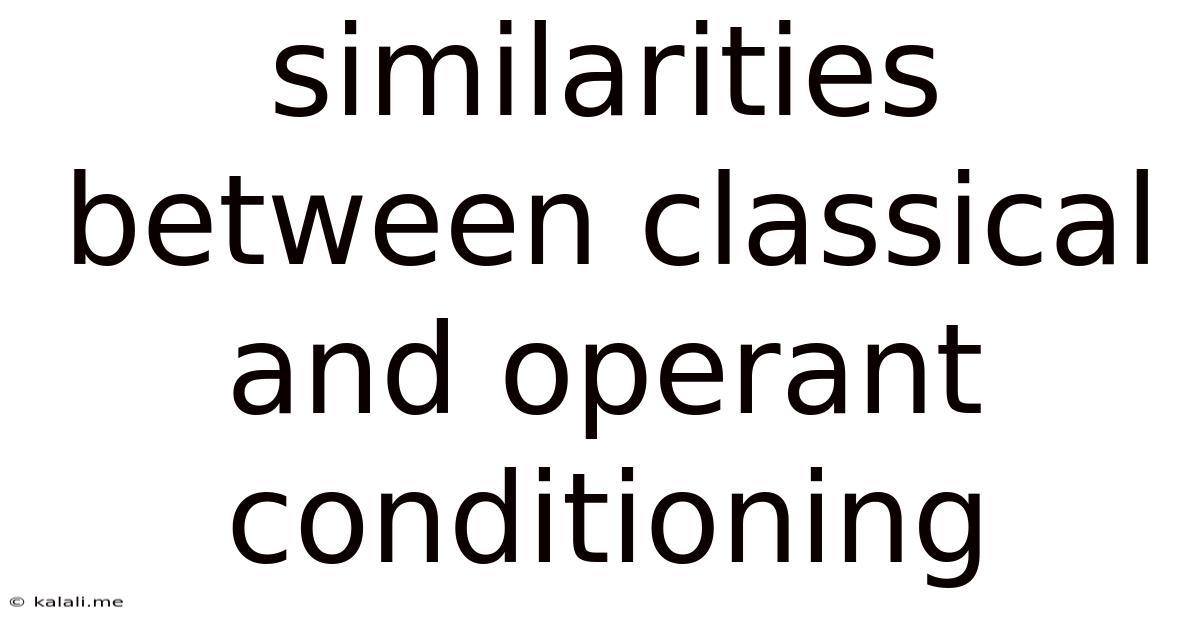Similarities Between Classical And Operant Conditioning
Kalali
Jun 11, 2025 · 3 min read

Table of Contents
Unveiling the Similarities Between Classical and Operant Conditioning
Classical and operant conditioning, two cornerstones of behavioral psychology, might seem disparate at first glance. However, a closer examination reveals intriguing similarities that underscore their shared foundation in learning through association and consequence. This article delves into the key overlaps between these influential learning theories, offering a clearer understanding of their interconnected nature. Understanding these similarities can significantly improve your comprehension of how learning processes shape behavior.
Classical conditioning, pioneered by Ivan Pavlov, focuses on associating a neutral stimulus with a naturally occurring stimulus (unconditioned stimulus) to elicit a conditioned response. Operant conditioning, developed by B.F. Skinner, emphasizes learning through consequences – reinforcement strengthens behaviors, while punishment weakens them. While their mechanisms differ, both share fundamental principles in shaping behavior.
Shared Principles: The Foundation of Learning
Both classical and operant conditioning are rooted in the principle of association. In classical conditioning, the association is between stimuli (a neutral stimulus and an unconditioned stimulus). In operant conditioning, the association is between a behavior and its consequences. This fundamental similarity highlights that learning fundamentally involves connecting events.
Another key similarity lies in the role of experience. Both theories emphasize the importance of environmental factors and personal experience in shaping behavior. Neither theory posits that behavior is solely determined by genetics or innate factors; instead, they highlight the active role of learning and adaptation through interaction with the environment. This shared emphasis on experience sets them apart from purely biological explanations of behavior.
Furthermore, both classical and operant conditioning processes demonstrate the phenomenon of extinction. In classical conditioning, extinction occurs when the conditioned stimulus is repeatedly presented without the unconditioned stimulus, leading to a weakening of the conditioned response. Similarly, in operant conditioning, extinction occurs when a previously reinforced behavior is no longer reinforced, resulting in a decrease in the frequency of that behavior.
Beyond the Basics: Further Connections
Both conditioning types also involve generalization and discrimination. Generalization refers to the tendency to respond similarly to stimuli that are similar to the conditioned stimulus (classical conditioning) or to similar behaviors (operant conditioning). Discrimination, conversely, involves learning to distinguish between stimuli or behaviors that lead to different outcomes. This ability to differentiate shows a sophistication in learning not initially obvious.
Moreover, both paradigms can be utilized in a variety of contexts, including therapeutic settings. Classical conditioning underlies techniques like exposure therapy and systematic desensitization, while operant conditioning forms the basis of behavior modification therapies. These parallel applications underscore the practical significance of both learning processes.
Conclusion: A Unified Perspective on Learning
While distinct in their mechanisms, classical and operant conditioning share remarkable similarities. Both rely on association, emphasize the significance of experience, and exhibit phenomena like extinction, generalization, and discrimination. These shared principles provide a unified framework for understanding how learning shapes behavior across various contexts, paving the way for effective interventions and a deeper appreciation of the complexities of human learning. Understanding these overlaps provides a more comprehensive understanding of behavioral psychology and its applications.
Latest Posts
Latest Posts
-
Elvis Presley Gospel One Pair Of Hands
Jul 01, 2025
-
What Is The Fine For Killing A Buzzard
Jul 01, 2025
-
How Old Am I If I Was Born In 1996
Jul 01, 2025
-
What Is 3 X 3 X 3
Jul 01, 2025
-
How Many Apples In A 3 Pound Bag
Jul 01, 2025
Related Post
Thank you for visiting our website which covers about Similarities Between Classical And Operant Conditioning . We hope the information provided has been useful to you. Feel free to contact us if you have any questions or need further assistance. See you next time and don't miss to bookmark.